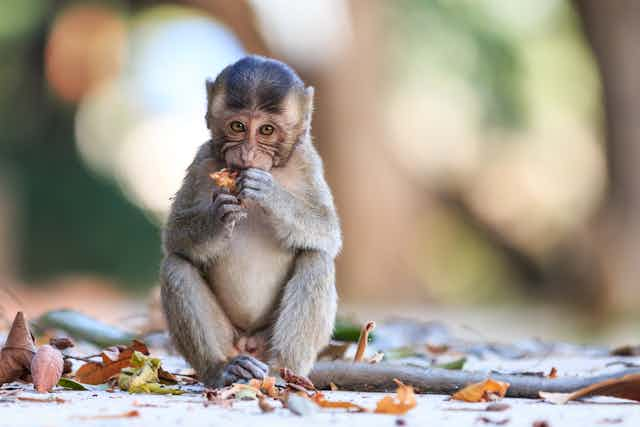When Kyoko Yoshida and his colleagues in Japan noticed one of their research monkeys was behaving strangely, they decided to study it more closely. They realised that some of the behaviour it was displaying – repetition, reduced social behaviours and an impaired ability to change behaviour in response to others’ actions – bore similarities to autism spectrum disorder (ASD) in humans. They found more similarities with autistic humans when they studied the monkey’s DNA.
Yet autism is a developmental condition defined by types of behaviour that are almost wholly unique to human beings. So is it really possible for a monkey to have autism? The new research from the Japanese team might not fully answer that question. But it does suggest that studying monkeys may help us understand what’s going on in the brains of people with autism and identify the causes of the condition.
There are good reasons to believe autism is an inherently human condition. The diagnosis of autism rests on abnormalities of those nonverbal types of behaviour that we use in social interaction to influence each others’ states of mind. This includes gestures, directed facial expressions and showing behaviours such as pointing.
Human condition
Autism is also closely associated with delays in language development, which is perhaps the most impressive human sensorimotor skill (involving senses and physical movement). Other types of autistic behaviours include those characterised by the ability to follow and direct another person’s focus of attention. This is arguably the most human of cognitive abilities and seen least in non-human primates.
But none of this means that non-human animals couldn’t have impaired neural mechanisms that are similar to those that occur in autistic humans, even if they cause more simple behavioural problems in the animals.
One idea about what causes autism is the mirror neuron hypothesis, which I advanced with co-authors back in 2001. Mirror neurons are a part of the brain first discovered in monkeys that activates when animals (including humans) perform certain actions and when they see others doing the same actions. Our theory was that when these mirror neurons didn’t work properly it could affect the ability to watch someone and judge what they were trying to do from their actions.
We proposed that the neural mechanisms the brain uses for sensorimotor learning (which includes the mirror neurons) are also used to understand other people’s actions and so to empathise with them. If these mechanisms are impaired then it is harder to infer what people’s intentions are from what they say and do. “Predictive coding models” extend this idea to explain how disrupted sensorimotor learning results in the heightened sensory awareness often experienced by people with autism, as well as repetitive behaviours that produce desirable sensations.

Macaque monkeys, like the one studied by Kyoko Yoshida, may not be very capable of inferring intentions, but we can still predict some effects of impaired mirror neuron function on their social behaviour.
Yoshida tested the monkey’s abilities using a simplified version of the Wisconsin Card Sorting Task, which involves matching picture cards according to the numbers, colours or shapes they represent. The rules for how to match the cards change throughout the game and the player has to guess how they have changed by trial and error. Just as occurs in people with autism, the monkey did not adapt its behaviour in response to watching another monkey following a new rule. The researchers also found that the monkey showed decreased socially affiliative behaviours (presenting himself for grooming or mounting).
As our theory would predict, the monkey did indeed have reduced numbers of mirror-type neurons. The researchers also found it had genetic variants that have been associated with autism, notably in a gene related to serotonin function, which has long been linked to the condition.
Not enough for a diagnosis
In their paper, the researchers said that they “considered that Monkey E had a particular disorder that could be called psychiatric, similar to human ASD”. As a psychiatrist, I am not particularly impressed with nail-biting, decreased social interaction and reduced performance in a single behavioural task being seen as enough to diagnose autism. Personally, I would be looking for a much more detailed description of social and repetitive behaviours throughout development.
But in principle, this research shows monkeys can display behaviour that is similar to that seen in humans with autism. What’s more, the common patterns of brain disruptions seen in both monkeys and humans are linked to genetic differences associated with autism in humans.
The approach taken by the researchers will be invaluable if it allows us to trace and define the long and complex path from genetics through neurophysiology to autistic behaviour. This could then explain how genetic differences cause the condition. What’s more, if it confirms that the way that the brain adapts its motor-control systems for social behaviour is the key process affected by autism, we will have found a promising target for therapy.

